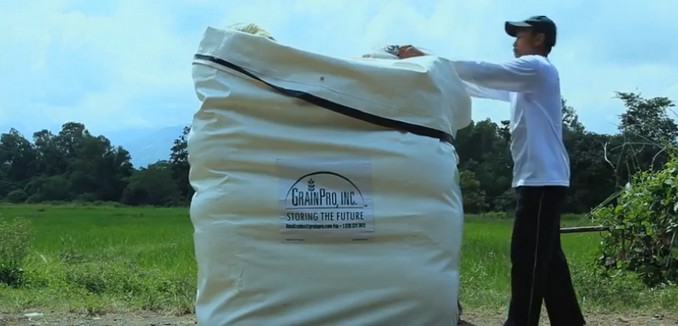A company headquartered in Concord, Massachusetts with Israeli roots is playing an important role in curbing global hunger, saving millions of people from malnutrition, and pulling farmers around the globe out of the cycle of poverty. Its invention is already doing great things, but much more can be done to help the people of the developing world. The Grain Cocoon, a hermetic storage bag, should be a standard arrow in the quiver of every global development agency, including USAID, that works with farmers.
Worldwide, 805 million people are chronically undernourished, and many farmers in the developing world still use burlap sacks to store their goods. Insects can easily infiltrate these bags, often destroying more than half of a farmer’s harvest. When farmers use pesticides, they often lead to extreme sickness and even death. And worse, over time, toxic products also become ineffective.
Inefficient storage techniques result in the loss of roughly 1.3 billion tons of food annually. That’s one-third of all food produced for human consumption, an amount sufficient to feed every starving person in the world. Reducing these losses, experts say, would play a critical role in the fight against world hunger.
Shlomo Navarro came to Israel from Turkey as a young adult in the 1960s. He later became a research entomologist at the Israel Agricultural Research Organization (VOLCANI), a prestigious institute where he worked for many years. As a result of his work, he developed the Grain Cocoon, a large, hermetically sealed bag for rice, grain, spices, and legumes. The bag can hold anywhere from five to 300 tons of grain. It’s made from polyvinyl chloride (PVC), a strong material that doesn’t tear easily. When farmers seal the bag, it traps bugs and their eggs inside and deprives them of oxygen, suffocating them to death, which makes pesticides unnecessary. On average, Navarro says, the cocoon can save more than 99 percent of a farmer’s crops. It can be used any time after harvest collection, and once grain is placed inside it, the insects generally die within about 10 days. Farmers can easily remove the dead bugs using a sieve or other techniques.
Not only does the Grain Cocoon protect the harvest from bugs and farmers from pesticides; it also helps the rural poor deal with the unpredictable forces of the free market. By storing grains immediately after a harvest, farmers can wait to sell them until prices rise. In cases of extreme poverty, Navarro encourages villages to invest in a communal cocoon so they can store excess grain collectively and use it as needed. Unless small farmers are able to make these types of choices, they and their families are often doomed to endless poverty.
Since GrainPro officially introduced Navarro’s cocoon in the early 1990s, it has been adopted in a hundred countries and saved their harvests from insects, rodents and other pests. The company has sold millions of cocoons and smaller, hermetically sealed bags across the developing world. It has customers in Arab countries, many of which have no diplomatic relations with Israel, as well as in Africa, Latin America, and Asia. The cocoons have become especially attractive to farmers and development agencies because they can reuse the bags multiple times over the course of several years. According to Martin Gummert, a senior scientist at the International Rice Research Institute, “The science and technology have been proven and the benefits are great. The challenge now is . . . making people aware.”
This includes farmers and aid agencies, some of whom view using pesticides as cheaper. But Professor Maria Otília Carvalho of the University of Lisbon, an expert on entomology, ecology and food storage, argues that in the long run, pesticides are in fact more expensive. “Given the health ramifications, potential loss of life and grain, to say nothing of the environment,” she says, “using hermetic storage comes out ahead” and “is the technology of the future.”
In 2016, the U.S. government passed the Global Food Security Act, which voiced a commitment to reducing hunger, malnutrition, and poverty around the globe. As part of this effort, USAID put together a comprehensive approach that includes helping farmers learn the best techniques to grow and store their crops. Unfortunately, there is almost no mention of the grain cocoon or hermetic storage on the USAID website, suggesting that this is far from an area of focus. Farmers and hungry children around the world should not be deprived of this potentially life-saving innovation.
Today, Navarro, in his mid-seventies, is widely recognized as a modern-day Joseph, the biblical figure who saved Egypt from famine by convincing Pharaoh to store grain underground. As Rabbi Irwin Kula of Clal–The Center for Learning and Leadership puts it, “The most traditional prayer is for a successful harvest — that God provide sustenance — bread, the staff of life. The Grain Cocoon technology is an answer to the ancient yearning that all people be fed.”
[Photo: GrainPro USA Inc. / YouTube ]




